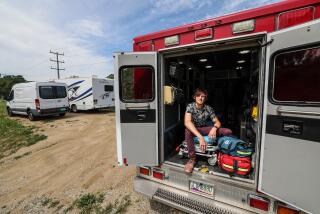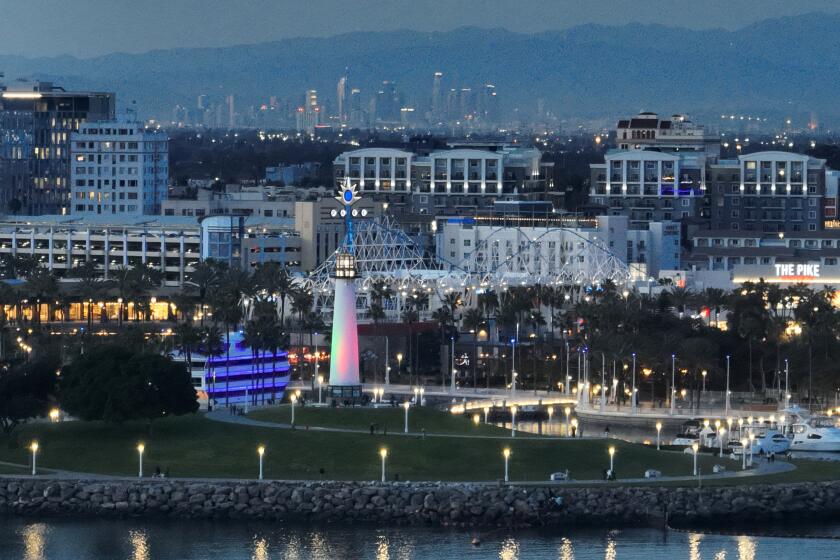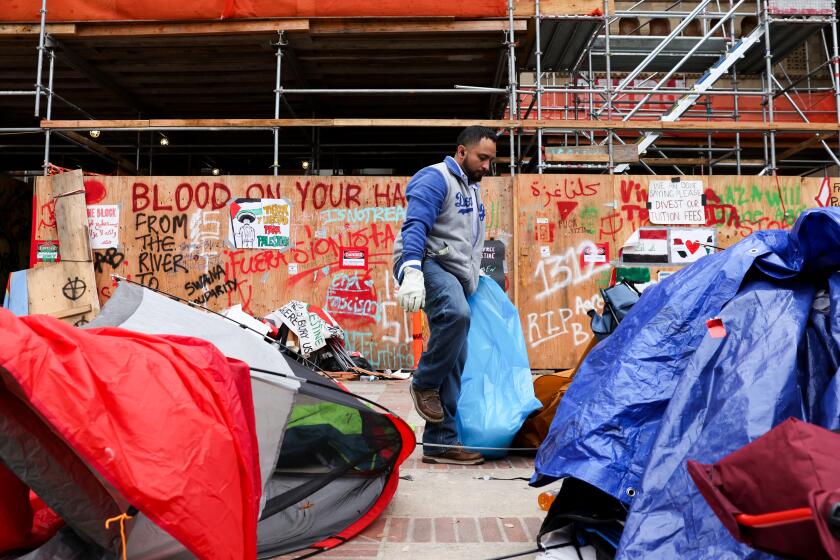Secession Camps Face Rising Odds
With less than two months left to persuade voters to break up Los Angeles, the secession campaign is short on cash, endorsements and high-profile candidates, and some backers doubt they can marshal enough grass-roots support to overcome the opposition.
Secession leaders are increasingly pinning their hopes on neighbor-to-neighbor appeals in living rooms and grocery stores. They’re counting on their smaller-government message to resonate with voters.
But some candidates for elective offices in the proposed cities are worried that the campaign has not connected with enough voters, especially outside the breakaway regions of the San Fernando Valley and Hollywood. The secession measures are on the Nov. 5 ballot.
“I’m concerned,” said Oscar Mendoza, a candidate for the proposed Valley city council. “I think we should have been going to the rest of Los Angeles by now.”
Mendoza said he believes the campaign has time to right itself, but some analysts say breakup backers are banging a drum that few people outside the Valley and Hollywood can hear.
“There’s no call for revolution,” Los Angeles pollster Paul Goodwin said. “People want change and there’s some call for reform, but the secession movement ... hasn’t been able to make a credible case that moves beyond a relatively small circle of people.”
Meanwhile, the anti-secession campaign led by Mayor James K. Hahn is steam-rolling ahead, with $3 million in contributions and supporters drawn from the political and business elite of Los Angeles. Running the campaign is a team of pros with one of the best track records in California.
Like a fledgling struggling to catch an updraft, the Valley secession camp has held at least three “kickoff” events.
Valley separatists say donors have given about $350,000 and pledged about $1.1 million more to the campaign, whose original fund-raising goal was $4 million. In Hollywood, the movement is largely financed by nightclub owner Gene La Pietra, who is heading the secession campaign and running for a city council seat.
The secessionists had hoped to attract a field of well-known candidates with the proven ability to raise money. But with the exception of Valley mayoral candidate and one-term Assemblyman Keith Richman (R-Northridge), none of the candidates now hold political office.
Municipal unions and other secession opponents made sure that no big-name contenders, like state Sen. Richard Alarcon (D-Sylmar), ran for office in the new cities by threatening not to support them. The novices who qualified for the ballot are running mostly homespun operations, not the full-tilt campaigns that secessionists once predicted would infect the city with independence fever.
Breakup leaders and some of the candidates have appeared outside the Valley and Hollywood in a series of forums. Richard Close, chairman of the secession group Valley VOTE, said the campaign plans to reach out more with mail, radio ads and public events aimed at voters beyond its base.
“We will be focusing south of Mulholland [Drive] at the appropriate locations at the appropriate time,” he said, adding that polling has identified communities, such as Westchester, where “people are totally frustrated with the Hahn administration.”
La Pietra said the Hollywood campaign will send mailers throughout the city, targeting areas such as Venice, Silver Lake and San Pedro. The campaign also plans to air at least two pro-cityhood television ads.
La Pietra, who says he has already contributed about $1 million to the Hollywood cause, including a large amount to get secession on the ballot, vowed to spend “whatever’s necessary to get the message out.”
To win, each secession measure must receive a majority of votes within either the Valley or Hollywood, and in the city as a whole.
So far, most polls have shown secession winning in the Valley but losing in Hollywood and Los Angeles as a whole.
“I don’t think the rest of the city, for the most part, cares,” Democratic consultant Eric Hacopian said. “It’s not something that really drives people. And if people are uncertain about something, they vote no.”
Each day seems to bring secession opponents another strong voice--last week’s came from former Los Angeles Police Chief Bernard C. Parks. By contrast, secession backers have endorsements from some Valley chambers of commerce, a Realtors’ association, and, in the case of Hollywood, Lt. Gov. Cruz Bustamante.
Some prominent Valley leaders sympathetic to the secessionists’ complaints have remained neutral. Los Angeles City Councilman Hal Bernson and county Supervisor Zev Yaroslavsky, both of whom served on the state panel that approved the secession proposals for the ballot, have declined to take a position on the measures.
Publicly, secession leaders remain upbeat. But criticism has mounted within the campaign since July, when Close and key secession backer David Fleming secretly met with opponents to discuss yanking the breakup proposals from the ballot in favor of a borough plan.
“I’m very disappointed,” said Valley mayoral candidate Leonard Shapiro. “The Valley group is not reaching out there. They are short-handed and they haven’t got the money and there is only so much they can do.”
Shapiro and fellow mayoral contender Marc Strassman said their advice to secession leaders to wage a more aggressive campaign has not been heeded.
“The case needs to be made more forcefully to the rest of Los Angeles that it will benefit them, just like the Valley,” Strassman said. “[The leaders] don’t listen to me. They don’t return my calls. I am disappointed they are not open to new ideas.”
One council candidate, who asked not to be identified for fear of retribution, said the central campaign is in disarray, with “political amateurs” fighting among themselves and providing no money to help the candidates.
Close denied there is division within the secession camp and said the campaign is in good hands with political veteran Richard Katz, a former assemblyman, among those at the helm.
In addition to holding almost daily news conferences, secessionists have launched a mail campaign. Valley cityhood backers last week sent 500 letters to members of neighborhood councils.
They plan to send mailers later this month to Valley voters, including an appeal to Sherman Oaks residents signed by Close, president of the Sherman Oaks Homeowners Assn.
Nearly 600 people have contributed to the Valley campaign, including 300 in the traditionally slow month of August, said Anne Dunsmore, the fund-raiser directing that effort.
“Over 25 years of fund-raising, I’ve never seen anything like this,” she said. It’s unclear whether the cash will buy secessionists television advertising, which can run up to $1 million a week on network channels. The effort could be limited to less-expensive cable stations, campaign insiders said.
Kam Kuwata, an anti-secession strategist, said his campaign will probably hit the television and radio airwaves toward the end of the month.
“Once we go up, we plan to stay up for the duration,” he said, adding that perhaps 90% of the $5 million the campaign plans to raise will go toward television ads.
More to Read
Start your day right
Sign up for Essential California for news, features and recommendations from the L.A. Times and beyond in your inbox six days a week.
You may occasionally receive promotional content from the Los Angeles Times.







